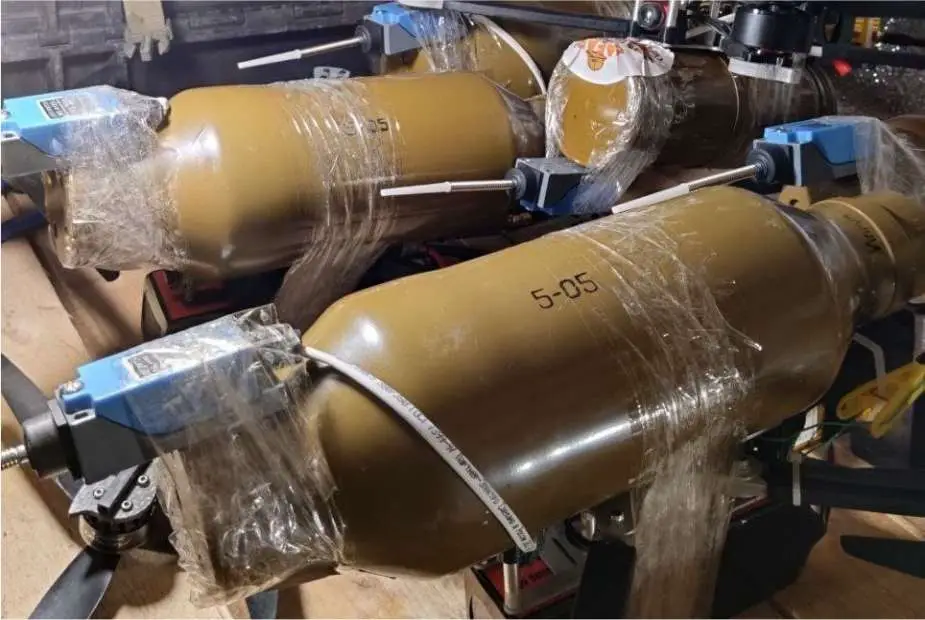- Army
- Conflicts in the world
- Israel - Iran conflict 2025
- Pakistan - India Conflict 2025
- Russia Ukraine War 2022
- Libya conflict day by day
- HAMAS - Israel War 2023
- Operation Serval in Mali French Army
- Sangaris operation Central African Republic
- Sangaris opération militaire République Centreafrique
- Ukraine - Russia conflict
- Syria conflict news
- Defence & Security Industry Technology
- Armies in the world
- Analysis Defense and Security Industry
- Conflicts in the world
- Navy
- Air
Russia arms kamikaze drones with TBG-7V thermobaric rocket in Ukraine
In the current context of the conflict in Ukraine, Russia has added a new dimension to its military strategy by employing kamikaze drones armed with TBG-7V thermobaric rockets. Drones are well-known today, but it's quite rare to see them armed with such destructive potential.
Follow Army Recognition on Google News at this link

TBG-7V thermobaric rocket strapped to a drone in Ukraine (Picture source: Russian social media)
In images, one can see a TBG-7V thermobaric rocket strapped to a drone. While the use of drones is not new, the employment of such munitions is quite surprising and especially provides a new level of destructive capability for a kamikaze drone.
Thermobaric rockets, like the TBG-7V, work by dispersing a cloud of combustible particles before igniting them, thus creating a massive explosion. This explosion not only produces a devastating shockwave but also consumes the surrounding oxygen, creating an asphyxiating effect. The uniqueness of these weapons lies in their ability to cause considerable damage over large areas, making their use particularly formidable in urban environments or confined spaces.
The TBG-7V, in particular, is designed for use with the RPG-7 grenade launcher, a widely spread and easily accessible weapon system. Its effective range is about 200 to 300 meters, with the ability to penetrate armored or fortified targets before triggering the thermobaric explosion. This versatility makes the TBG-7V especially suitable for mounting on drones, thus adding a new dimension to its battlefield application, and significantly increasing its range.
The use of kamikaze drones equipped with such munitions in Ukraine offers several tactical advantages. Notably, the increased precision of strikes allows for specifically targeting key infrastructures or concentrations of enemy troops.
The weight of a TBG-7V, adapted for use with the RPG-7 grenade launcher, is about 4.5 kg. This munition is designed to be relatively lightweight while maintaining considerable explosive power, making it compatible with various launch platforms, including drones.
To effectively transport and deploy a payload like the TBG-7V, a drone must possess certain key characteristics. First, it must have sufficient lifting capacity. Taking into account the weight of the bomb (4.5 kg), the drone must be able to lift this weight in addition to its weight and that of any other onboard equipment, such as guidance and control systems. Typically, for a payload of 4.5 kg, a medium or large drone would be required, with a propulsion system powerful enough to ensure stability and maneuverability during flight. The power must be sufficient not only to lift the load but also to ensure adequate flight duration, stability in variable weather conditions, and the ability to navigate precisely to the target.
Besides lifting capacity, other technical aspects are important for the effective operation of such drones. This includes a reliable guidance system (such as GPS or other navigation systems), a secure data link for remote control, and possibly obstacle detection and avoidance systems to operate in complex environments.
The integration of kamikaze drones equipped with TBG-7V thermobaric bombs by Russia in Ukraine is interesting because of its potential for destruction. Although this technology offers undeniable tactical advantages, its real effectiveness on the battlefield remains to be seen.


























